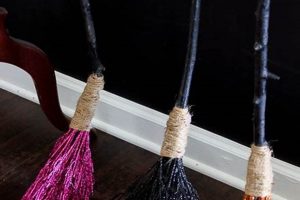This traditional light source, typically crafted from clay, utilizes oil or ghee and a cotton wick to produce illumination. It serves not only as a practical source of light but also carries significant cultural and religious importance, particularly within South Asian traditions. For example, these earthenware lights are often used during Diwali celebrations, symbolizing the triumph of good over evil and light over darkness.
The significance of these small lamps extends beyond mere illumination. They represent prosperity, knowledge, and new beginnings. Historically, they have been used in homes, temples, and outdoor spaces to create a warm and inviting atmosphere. The soft glow emitted from the burning wick is believed to ward off negative energies and attract auspiciousness. The use of natural materials further adds to the inherent value and eco-friendly aspect of this lighting method.
The following sections will delve deeper into the various aspects associated with this traditional light source, including its construction, cultural relevance, and contemporary adaptations, as well as the associated symbolism and sustainable practices. This will provide a thorough understanding of its multifaceted nature and enduring appeal.
Illuminating Insights
The following offers guidance on the selection, usage, and maintenance of these traditional light sources, ensuring safety, longevity, and the maximization of their inherent benefits.
Tip 1: Select Quality Materials: Opt for lamps constructed from high-quality clay. A well-fired piece will be more durable and less prone to cracking during use. Ensure the wick is made of natural cotton for optimal oil absorption and consistent burning.
Tip 2: Choose the Appropriate Fuel: Employ either ghee (clarified butter) or a good quality oil specifically intended for lamps. Refrain from using flammable or volatile liquids as fuel to avoid hazardous situations.
Tip 3: Prepare the Wick Correctly: Before lighting, soak the cotton wick thoroughly in the chosen fuel. This ensures a steady and even flame, minimizing smoke production and maximizing burn time. A properly saturated wick is crucial for a consistent and safe experience.
Tip 4: Position with Care: Place the lit lamp on a stable, non-flammable surface, away from curtains, paper, or other easily combustible materials. Ensure adequate ventilation to prevent the accumulation of smoke and fumes.
Tip 5: Monitor Constantly: Never leave a burning lamp unattended. Regular monitoring is essential to prevent accidents and ensure the flame remains stable and within a safe range. Extinguish the flame completely before leaving the area.
Tip 6: Storage Considerations: Store unlit lamps in a dry, protected area to prevent moisture absorption, which can compromise their integrity and longevity. Keep unused wicks in a sealed container to maintain their dryness and pliability.
Tip 7: Extinguish Safely: Use a flame snuffer or carefully blow out the flame, ensuring no hot embers remain. Avoid using water to extinguish the flame, as this can cause the oil to splatter and potentially cause injury.
Adhering to these guidelines ensures the safe and efficient use of these lights, maximizing their potential for illumination, ambiance, and symbolic representation. These practices will extend the lamp’s lifespan and minimize potential hazards.
The subsequent sections will provide more detailed insights into the cultural and artistic dimensions, offering a holistic understanding of these timeless sources of light.
1. Illumination
Illumination represents the primary functional aspect of the traditional light. It is the intended purpose of its design and construction, serving as a source of light for various settings. The nature and quality of this light hold specific significance in both practical and symbolic contexts.
- Light Quality and Spectrum
The light emitted from the lamp differs significantly from modern electric lighting. Typically, the light produces a warm, yellow glow due to the combustion of natural oils or ghee. This specific spectral composition is perceived as softer and less harsh than artificial light, contributing to a more relaxing and intimate atmosphere. The absence of blue light minimizes potential disruptions to circadian rhythms, making it suitable for evening use.
- Area of Coverage and Intensity
The traditional light is typically characterized by a relatively low intensity and limited area of coverage. Its purpose is not to flood a large space with bright light but to provide localized illumination, creating pockets of visibility and shadow. This deliberate limitation enhances the ambiance, drawing attention to specific focal points while allowing the surrounding areas to recede into darkness.
- Duration and Consistency
The duration and consistency of the illumination provided by a diya are contingent upon several factors, including the type and quantity of fuel, the wick material, and environmental conditions. Regular maintenance, such as trimming the wick, is crucial to maintaining a steady and consistent flame. Fluctuations in the flame’s intensity can occur, adding to the inherent charm and unpredictability of this traditional light source.
- Symbolic Significance of Light
Beyond its practical function, illumination carries deep symbolic weight. Light, in many cultures, represents knowledge, hope, and the dispelling of ignorance or negativity. The act of lighting the traditional light signifies an invocation of these positive attributes, reinforcing its role as a spiritual and cultural artifact. The presence of light itself is a visual affirmation of these ideals.
These dimensions of illumination highlight the multifaceted role the light plays. It is more than a mere source of light. It creates a unique sensory experience and serves as a tangible symbol of cultural and spiritual values. The light’s inherent qualities are intertwined with the tradition of the lamp itself.
2. Material
The composition of a traditional light source significantly impacts its functionality, longevity, and symbolic value. Clay, the most prevalent material, offers both accessibility and thermal properties suitable for containing and moderating the heat produced by burning oil or ghee. The quality and type of clay used directly influence the structural integrity of the lamp; poorly fired or low-grade clay can lead to cracking or crumbling, rendering the lamp unusable. For example, terracotta, a common type of earthenware clay, provides sufficient heat resistance for safe operation. Conversely, less dense materials are unsuitable due to the risk of heat-induced failure. The selection of appropriate materials is, therefore, fundamental to the effective and safe use of this light source.
Beyond structural considerations, the material also plays
a role in the lamp’s aesthetic and cultural significance. Variations in clay type, glazing techniques, and decorative elements contribute to the diverse range of styles found across different regions and communities. The color and texture of the clay, for instance, may be deliberately chosen to align with specific cultural aesthetics or religious traditions. In some instances, precious metals or semi-precious stones are incorporated into the lamp’s design, elevating its status and signifying its use in particularly important ceremonies. This careful material selection and craftsmanship underscore the cultural and artistic value associated with these traditional lamps.
In conclusion, the correlation between material and the utility of the traditional light is multifaceted. The choice of appropriate materials is essential for safe operation, structural durability, and aesthetic expression. Understanding the properties and cultural significance of the materials used in the construction of these lamps is critical for appreciating their role as both functional objects and symbols of cultural heritage. The link between material and craftsmanship is central to preserving the cultural integrity and practical utility of this traditional item.
3. Fuel
The selection of fuel is paramount to the function and symbolism of a traditional light source. It directly influences the quality of light produced, the duration of illumination, and the overall aesthetic and ritualistic experience associated with the lamp.
- Type of Fuel and Light Emission
Different fuel types produce distinct light characteristics. Ghee (clarified butter), commonly used in religious contexts, emits a clean, bright flame with minimal smoke. Vegetable oils, such as sesame or coconut oil, offer a readily available and more economical alternative, though they may produce a slightly less intense flame and potentially more smoke. The chemical composition of the fuel directly determines the color temperature and intensity of the light emitted.
- Fuel and Burn Duration
The viscosity and energy density of the fuel dictate the burn duration of the lamp. Higher viscosity fuels, such as ghee, tend to burn slower and provide a longer illumination period compared to less viscous oils. The rate of fuel consumption is also influenced by the wick’s material and its ability to draw fuel efficiently. Careful consideration of these factors is essential for achieving the desired burn time.
- Fuel and Aromatic Qualities
Certain fuels impart subtle aromatic qualities during combustion, enhancing the sensory experience associated with the lamp. Ghee, in particular, releases a characteristic fragrance considered auspicious in many traditions. Similarly, the use of specific essential oils as additives can introduce additional fragrances, further enriching the ritualistic or ambient atmosphere. The choice of fuel, therefore, extends beyond mere functionality to encompass olfactory elements.
- Fuel Purity and Environmental Impact
The purity of the fuel directly impacts the environmental and respiratory health aspects associated with the lamp’s use. Impurities in the fuel can lead to the release of harmful particulate matter and noxious gases during combustion. Selecting high-quality, refined fuels minimizes these negative effects. Sustainable sourcing of fuel, such as using locally produced vegetable oils, can further reduce the environmental footprint of this traditional practice.
The choice of fuel for a traditional light transcends simple practicality; it encompasses considerations of light quality, burn duration, aromatic properties, and environmental responsibility. The selection is integral to maximizing the lamp’s function and significance within cultural and spiritual contexts. The proper selection is vital for the full value of the lamp.
4. Tradition
Tradition, as it relates to the traditional light source, forms the bedrock of its enduring significance. It is within the framework of established customs and practices that these lamps acquire meaning beyond mere illumination, becoming potent symbols of cultural and religious heritage.
- Ritualistic Use
The use of the light in ritualistic contexts, such as religious ceremonies and festivals, is a cornerstone of its traditional value. For example, during Diwali, rows of these lights are lit to symbolize the victory of light over darkness and good over evil. The act of lighting the lamp itself becomes a sacred ritual, passed down through generations and imbued with deep spiritual meaning. These practices solidify the lamp’s role as a central element in communal and personal observances.
- Generational Transmission
The knowledge and skills associated with the construction and use of traditional lamps are often transmitted through familial lines. This intergenerational transfer ensures the continuity of traditional techniques and safeguards the cultural significance of the craft. Elders instruct younger generations in the selection of materials, the shaping of the clay, and the proper methods for lighting and maintaining the lamp, preserving the lamp’s legacy. This preservation is critical.
- Symbolic Representation
The traditional lamp is replete with symbolic associations that are deeply rooted in cultural narratives. The flame represents the human soul, striving towards enlightenment, while the oil or ghee symbolizes devotion and purity. The act of offering light is viewed as a means of connecting with the divine, expressing gratitude, and seeking blessings. These symbolic interpretations vary across cultures and regions, but they consistently reinforce the lamp’s role as a powerful symbol of spiritual aspiration.
- Cultural Identity Marker
These lights often serve as a marker of cultural identity, distinguishing specific communities or regions through unique designs and customs. The shape, size, and decorative motifs of the lamp may reflect local artistic traditions and cultural beliefs. For instance, certain communities may favor lamps adorned with specific deities or geometric patterns, while others may adhere to simpler, more minimalist designs. These variations contribute to the rich diversity of traditional lamps and their role as emblems of cultural heritage.
These facets illustrate the integral connection between tradition and the significance of the traditional light. Through ritualistic practices, generational transmission, symbolic representation, and cultural identity, these lamps embody a wealth of historical and cultural meaning. Their continued use and preservation ensure that these traditions endure, serving as a tangible link to the past and a source of cultural pride for future generations.
5. Symbolism
The inherent significance of the traditional light extends far beyond its practical utility as a source of illumination. Symbolism is intrinsically woven into every aspect of this light source, transforming it into a powerful emblem of cultural, religious, and philosophical concepts.
- Light Over Darkness
The primary symbolism associated with the
light lies in its representation of the triumph of light over darkness. This concept resonates across numerous cultures and religions, signifying the victory of good over evil, knowledge over ignorance, and hope over despair. The act of lighting the lamp symbolizes the dispelling of negativity and the welcoming of positivity into one’s life and surroundings. For instance, during Diwali, the festival of lights, numerous lamps are lit to celebrate this symbolic victory. - The Inner Self and Enlightenment
The flame of the light is often interpreted as a representation of the human soul or the inner self. The upward direction of the flame signifies the soul’s aspiration for enlightenment and its inherent connection to the divine. The constant burning of the flame symbolizes the continuous pursuit of knowledge and self-improvement. In many spiritual traditions, the light serves as a reminder to cultivate inner peace and strive for spiritual growth.
- Purity and Devotion
The fuel used in the light, whether ghee or oil, symbolizes purity and devotion. Ghee, in particular, holds a sacred status in many religious practices and is considered an offering to the divine. The act of lighting the lamp with pure fuel signifies the offering of one’s devotion and gratitude. The clear, steady flame produced by high-quality fuel represents sincerity and unwavering faith.
- Prosperity and Auspiciousness
The presence of the light is believed to attract prosperity and auspiciousness. It is often lit at the beginning of new ventures or during important ceremonies to invoke blessings and ensure success. The light’s warm glow creates a welcoming and positive atmosphere, inviting good fortune and warding off negative energies. The lighting of the lamp is, therefore, viewed as an act of invoking divine grace and securing positive outcomes.
These multifaceted symbolic interpretations underscore the profound cultural and religious significance. Far from being a mere source of light, it serves as a tangible representation of deeply held beliefs and values. Its enduring presence in various traditions is a testament to its power as a symbol of hope, knowledge, and spiritual enlightenment.
6. Construction
The method of construction is fundamental to the functionality and cultural value of the traditional light. From material selection to the final shaping and finishing, each step contributes to the lamp’s performance, durability, and aesthetic qualities. The techniques employed often reflect regional traditions and available resources.
- Material Selection and Preparation
The choice of clay is critical. Ideally, the clay should be fine-grained, free of impurities, and possess sufficient plasticity to allow for shaping without cracking. Preparation involves removing stones and organic matter, followed by kneading the clay with water to achieve the desired consistency. The clay’s properties dictate the lamp’s heat resistance and overall structural integrity. Incorrect preparation can result in a fragile lamp prone to breakage during use.
- Shaping Techniques
Traditional shaping techniques include hand-molding, wheel-throwing, and the use of molds. Hand-molding allows for intricate designs and unique forms, while wheel-throwing is suitable for producing symmetrical, uniform lamps efficiently. Molds enable mass production while maintaining consistent dimensions. The selected technique influences the complexity of the design and the production rate. For example, ornate lamps often require hand-molding, whereas simpler designs can be efficiently produced using molds.
- Firing Process
Firing transforms the raw clay into a durable ceramic. The firing process involves gradually increasing the temperature in a kiln to harden the clay and remove moisture. The firing temperature and duration depend on the type of clay used. Under-firing results in a weak, porous lamp, while over-firing can cause warping or cracking. The firing process is critical for ensuring the lamp’s heat resistance and structural stability. Skillful firing techniques are essential for producing high-quality, long-lasting lamps.
- Finishing and Decoration
Once fired, the lamp may undergo further finishing and decoration. This can include glazing, painting, or the application of decorative elements. Glazing provides a smooth, waterproof surface and enhances the lamp’s aesthetic appeal. Painting and decorative elements add visual interest and can convey symbolic meanings. The finishing techniques employed reflect cultural preferences and artistic traditions. For example, some lamps are adorned with intricate patterns or religious symbols, enhancing their cultural significance.
These components collectively define the construction process of these traditional lights. The integration of skilled craftsmanship with appropriate materials and techniques results in a light source that fulfills both practical and cultural needs. A comprehensive understanding of these construction aspects is vital for appreciating their enduring value.
7. Safety
The safe operation of a traditional light source necessitates a thorough understanding of the inherent risks associated with open flames and flammable materials. The uncontrolled burning of oil or ghee can lead to accidental fires, posing a threat to property and personal safety. Careful selection of materials, proper placement, and constant monitoring are essential preventive measures. Real-life examples of house fires ignited by unattended lamps underscore the critical importance of adhering to safety guidelines. The absence of precautions can transform a source of light and cultural significance into a potential hazard.
Practical applications of safety protocols include using flame-retardant surfaces beneath the lamp, maintaining a safe distance from flammable materials such as curtains or paper, and ensuring adequate ventilation to prevent the accumulation of smoke. The use of long-handled lighters or tapers minimizes the risk of burns while igniting the wick. Regularly trimming the wick reduces smoke production and prevents the flame from growing excessively large. These proactive measures significantly reduce the likelihood of accidents and contribute to a safer environment. Furthermore, readily accessible fire extinguishers or water sources should be available in case of emergency. Consistent adherence to these safety measures is crucial.
In summary, prioritizing safety when using the traditional light is not merely a recommendation but a necessity. Understanding the potential risks, implementing preventive measures, and remaining vigilant are essential for mitigating hazards. The cultural and symbolic value of the lamp should not overshadow the importance of responsible usage. By integrating safety protocols into the traditional practice, the positive aspects of the lamp can be enjoyed without compromising well-being. Ignoring safety principles undermines the very purpose the light serves, potentially turning a symbol of enlightenment into a source of danger.
Frequently Asked Questions About Traditional Clay Lights
The following addresses common inquiries concerning the use, care, and cultural significance of traditional clay lights, providing clear and concise answers to promote understanding and safe usage.
Question 1: What types of
fuel are appropriate for a clay light, and which should be avoided?
Ghee (clarified butter) and refined vegetable oils, such as sesame or coconut oil, are suitable choices. Fuels with low flash points or containing additives, such as kerosene or motor oil, pose significant fire hazards and should be strictly avoided.
Question 2: How does one properly extinguish a clay light to prevent accidents?
The flame should be smothered using a flame snuffer or carefully blown out, ensuring that no embers remain. Water should not be used, as it can cause the hot oil or ghee to splatter, potentially causing burns or spreading the fire.
Question 3: How often should the wick of a clay light be trimmed?
The wick should be trimmed regularly to maintain a stable, controlled flame and minimize smoke production. A wick that is too long will produce excessive smoke and may flicker erratically. A trim of every 1-2 hours of burning is suggested.
Question 4: What are the ideal placement considerations for a burning clay light?
The light should be placed on a stable, non-flammable surface away from combustible materials such as curtains, paper, or flammable liquids. Adequate ventilation is also required to prevent the accumulation of smoke.
Question 5: How should clay lights be stored when not in use?
Clay lights should be stored in a dry location to prevent moisture absorption, which can weaken the clay and increase the risk of cracking during subsequent use. Wicks should be kept in a sealed container to maintain their dryness.
Question 6: Is there a specific disposal method for used oil or ghee from the clay light?
Used oil or ghee should be allowed to cool completely before disposal. It should not be poured down drains, as it can solidify and cause blockages. Proper disposal methods include sealing the cooled oil in a container and discarding it with household waste or disposing of it at a designated recycling facility, if available.
Proper usage, maintenance, and disposal ensure safety and longevity.
The following sections will further elaborate on their production.
Diya Lamp
This exposition has examined the multifaceted aspects of the traditional light source. The preceding discussions highlighted its construction, cultural relevance, symbolism, and safety considerations. The careful selection of materials, the adherence to established traditions, and the mindfulness of safety protocols were presented as essential elements for responsible utilization. The intricate interplay of illumination, cultural heritage, and symbolic representation underscores the lasting importance of this light source.
In conclusion, the traditional clay light continues to serve as a potent symbol of cultural heritage and spiritual aspiration. Its enduring presence in various traditions is a testament to its capacity to transcend mere functionality, embodying deeper values and beliefs. As practices evolve and cultural landscapes shift, the preservation of traditional knowledge and responsible usage are critical to ensuring that this time-honored light source continues to illuminate both physical spaces and the collective human spirit.







